ISSN: 1705-6411
Volume 5, Number 1 (January 2008)
Author: Dr. Gerry Coulter1

1. William Eagleston – Untitled (1970)
My interest in the object has always been for the non aesthetic object, the banal object…2
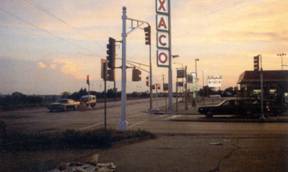
2. Steven Shore – Untitled (1972)
The best photographs retain something of this sense of surprise – of having captured the light of the object, but at the same time having been seized by that light.3
I. Introduction
In “The Baudrillardian Photograph As Theory…”4 we argued that the longing for each other by texts and images is complex in that it may pass from one photographer/ writer to another. Specifically, we point to the case of some of Reid’s photographs which look very much like photographs taken by Baudrillard (even though at the time of their taking Reid had never seen Baudrillard’s photography). Several readers have enquired about other contemporary photographers who could be said to share a Baudrillardian sensibility toward the object. Others have noted that a good deal of contemporary photography is supported by theories which stand in stark opposition to Baudrillard’s writing on photography. As one reader (who prefers Baudrillard’s thought on photography) asked: “…given the increasing importance of the digital how much longer will Baudrillard’s thought on photography remain relevant”?
This paper is a discussion of images by sixteen contemporary photographers whose work intersects with Baudrillard’s images and his writing on photography in some significant way. It points to representatives of two groups: 1) works by seven photographers who share the “Baudrillardian eye” (Armando Tudela, Rochelle Costi, Geert Goiris, Rinko Kawauchi, An-My Lê, Zoe Leonard, and Camilo José Vergara);
2) Works by nine photographers which deeply challenge Baudrillard’s approach (Rut Blees Luxemburg, Florian Maier-Aichen, Sophy Ricket, Peter Fraser, David Bliss, the AESF Group, Alexander Apostol, Luchezar Boyadjiev, and Kelli Connell). In both cases (whether or not the photographer is aware of Baudrillard’s texts on photography or his photographs), we see that his assertions about photography remain central to contemporary discourse and photographic practice.5
II. Baudrillard and/in Contemporary Photography
a) Cracks in the world

3. Baudrillard – Sao Paolo (1998)
In both his writing and in his photography Baudrillard had a highly sharpened awareness of the veil being lifted and cracks opening in the illusion of reality. Sao Paolo (1998) is also highly representative of his work as a photographer in that it captures the object in bright natural light at the surface level of appearances. This photograph is a visual poem complimenting his belief that we do not know the real, merely the appearances behind which the real hides. Behind the appearance of a wall lies a reality we cannot discern although the separating pieces of the wall indicate its existence. Whatever lies behind the opening which time and the elements are making in this wall we will never know. It is a photograph that makes a world which is given to us as enigmatic and unintelligible even more so.6
Baudrillard’s blank billboard in Las Vegas (1996) acknowledges a debt to

4. Baudrillard – Las Vegas (1996)
Marshall McLuhan as in this case the medium is indeed the message – and how rare to see/hear a medium speak of “nothing” so well. Finally we have a billboard which speaks to the nothing and ultimately to the system’s hidden non-meaning.
Some of Armando Tudela’s recent work is suggestive of Baudrillard’s approach to photography and meaning. Baudrillard writes: “All that lives by
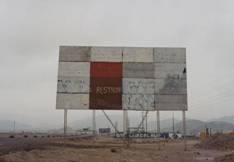
5. Tudela – Billboard (2003)7
meaning will perish by insignificance”.8 Tudela’s billboard stripped bare of even a white screen speaks not to objects but the very nothingness of the object. You could say that Tudela’s billboard takes Baudrillard’s one more step – as Baudrillard’s is a blank screen poised to speak – meaning could return at any moment. Tudela’s, on the other hand, addresses a more primitive and rudimentary meaninglessness which rests beneath the surface of the screen – indeed, in its ruined state. Here Tudela’s photograph approaches dangerously close to the reality of the system which is there just beneath the surface of the deteriorating screen. It is a photograph which participates in the abolition of meaning and, as often happens when meaning is abandoned, the effect can be quite poetic.9
Untitled (2005) is not unlike Baudrillard’s Sao Paolo (1998) in that it records a crack opening in the surface of the world. You could read a kind of
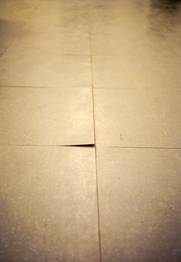
6. Tudela – Untitled (2005)
Nihilism into either Tudela or Baudrillard’s photographs but for me they represent only an obsession with disappearance – with reversibility – the inevitability of ruin and decay for all things and all systems. The billboards, the wall in Sao Paolo, the lifting tile of the floor – these are photographs of objects taking leave of themselves – fragments of an enigmatic world in a constant state of flux. These are photographs of the vital illusion – the illusion of appearances that governs our world – and that, by a Baudrillardian reading, is always an optimistic view. Where Tudela’s images differ from Baudrillard’s, and it is precisely the point where they become less interesting to me, is in their lack of use of natural light. Tudela’s “ruins” (especially his billboards) would be stronger evocations of remains if they were taken in sunlight. Although I should acknowledge here that Baudrillard appreciated images taken on heavily clouded days: “good photographs can only be taken in brilliant light on perfectly clear days or under a leaden sky, in both cases, either by their brilliance or their mutedness, the colours stand out”.10 The lack of natural light in Tudela’s images touches on a larger issue though as the pervasive melancholy (directly linked to sunlight striking the object at an oblique angle) running though so many of Baudrillard’s images is lacking in Tudela’s work. Perhaps Tudela’s images can be read as indifferent even to melancholy and as such representative of a challenge to Baudrillard’s euphoric understanding of our saturated system.11
Rochelle Costi is another contemporary photographer whose work intersects with that of Baudrillard in a similar manner capturing enigmatic moments in the construction of people’s dwelling places. In Tijolo a vista (2003) someone has hand painted the appearance of a brick wall over bare plywood sheeting. Here even the reality of poverty attempts to situate itself beneath the appearance of a more sturdy exterior. As in Baudrillard’s Sao Paolo the cracks of ruination open as the plywood
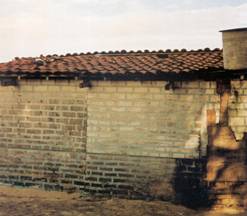
7. Costi – Tijolo a vista (2003)
has begun to disintegrate. As in the vast majority of Baudrillard’s photographs we do not see people but merely the objects which signify their existence. Human absence here serves to illustrate not only disappearance but marginality – the marginal existence of the occupant of this dwelling while pointing to the vital relationship between people and objects. Like so many of Baudrillard’s images, Costi’s Tijolo a vista, indifferently records what could easily be a understood as a politicized image, but in a manner which is also not in any way supportive of the system. This image records something of what Baudrillard refers to as an ambivalence which awaits even the most advanced systems.12 It also points to the illusory nature of globalization (especially the myth of an increased standard of living accompanying the spread of capitalist production), as it represents what the majority of dwellings on planet earth now resemble. Costi’s photograph brings home to the prosperous world of art and photography galleries other realities – what Baudrillard refers to as “the bottom-up leveling”.13 As we survey its deteriorating state we are reminded of the strong current of reversibility that inhabits our world and that the globe itself resists globalization.14 The sun (natural light is present here, muted by shadows) may well be setting on more than this house.
b) The world as strange attractor
One of the more remarkable things that certain of Baudrillard’s photographs do (such as Salins, 1998) is to force us, in a science fiction age, to wonder what world (ours or some other) we are being shown. This is an aspect

8. Baudrillard – Salins (1998)
of Baudrillard’s work shared by Geert Goiris’s Ministry of Transportation (2003). Goiris has a gift for finding parts of the world (interiors and exteriors) that look as if they are parts of another world. Often a sense of the surreal overtakes his images even though they are not digitally altered. Photographs like Baudrillard’s

9. Goiris – Ministry of Transportation (2003)
Salins or Goiris’s Ministry of Transportation introduce uncertainty into our already piqued skepticism (in the digital age) concerning the photograph. These photographs point to the extraordinary aspects of ordinary objects in the world. Again, as in the work of Costi, we feel a strong human presence although no one is seen in the image – it is a marvelous photograph of the human world in our absence. The truly strange element in a photograph by Goiris (and often by Baudrillard) is the photograph itself. This is the secret of the surreal that appears momentarily on the surfaces of his images then evaporates as we look more closely for its point of irruption.
Goiris’s image reminds us that photography is a medium dependent upon the object as much or even more than it is the subject/photographer. Such a photograph, while recording the existence of a particular object – one fragment of the world – makes a curious demand on truth. There it is, you can see it – the photograph as “index” – yet the object so dominates the image that our sense of subjective truth gives way to the power of the object and its strange attraction. It is the world and its objects which become the source of a definitive uncertainty 15 – including any certainty we may have concerning the power of the photographer. The myth is that it is the photographer who commands the presence of the object and makes it appear in images.16 Photographs like Goiris’s and Baudrillard’s call into question this assumption as the power of the photographer is reduced to the will to close the shutter on the object which commands our attention over everything else in the world. If photography is an image of one fragment of the world with everything else removed, it is also an effort to record the power of the object with the myth of the omnipotence of the photographer stripped away. As in Baudrillard’s enigmatic photograph of a car submerged in water (Saint Clement, 1987) the
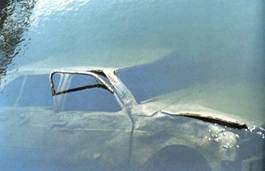
10. Baudrillard – Saint Clement (1987)
photographer has fallen under the spell of a very strange attractor. This is not to say that the photographer/subject is powerless against the photographed object merely that the photographer shares power with the object – a power we all too often ignore in our discussion of photography. To take in hand a camera, as Baudrillard did, is to surrender ourselves to the seductive power of objects and to become the prey of appearances.17 What I like about Goiris’s image is that it reminds us that photography is not merely the object taken from the point of view of the subject but the subject from the vantage point of the object. Nowhere is this more problematic than in the effort to photograph other living things.
c) Privileging an absence
Photographing the human face is something Baudrillard very rarely did. He expressed difficulty in photographing living beings in general “because they are themselves so charged with meaning that it’s almost impossible to set it aside to find the secret form of their absence”.18 This is the kind of mysterious or enigmatic quality that a painter like Francis Bacon attempts to achieve in his portraits inserting abstract elements to represent parts of the sitter he cannot (even if it is a close friend) claim to know or understand.19 Rinko Kawauchi accepts this challenge head on and replies with an image that responds to
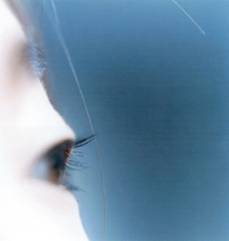
11. Kawauchi – Untitled. (2005)20
Baudrillard’s problem with a rather Baudrillardian solution – the fragment. The photograph of a fragment of a human face introduces the asymptotic free point of interaction between the human and the inhuman. It is a way of imaging our disappearance and of seeking out the inhuman purity of the world.
Kawauchi has taken a number of exceptional photographs of fragments of the face and heads (usually the eyes, ears, hands or feet), and none more striking than Untitled (2005). The face is an ever changing record of our fleeting and ephemeral identities and constant illusion of presence. Kawauchi’s close-up of a fragment of a face allows the individual features of the face, its totality, to remain absent and thus we have a highly enigmatic rendering of part of a human face. Kawauchi’s photographs of people may be the best ever taken of the human while remaining respectful of the absence of the person photographed.

12. Baudrillard – Toronto (1994)
Baudrillard’s Toronto (1994) is only able to achieve this effect by photographing the service station attendant from a distance without his knowledge of being photographed. This image, which shares a good deal in common with Edward Hopper’s paintings of bright light breaking across the surface of houses, leaves the otherness and absence of the attendant in tact while photographing a person and his double (shadow).21 Kawauchi’s challenge is to privilege such absence but at the most difficult range – close up. Kawauchi strips from the human object all of its dimensions – including meaning.22 It is among the most difficult things one can do with a camera – to come up close to a human face, where there is always an excess reservoir of meaning waiting to wash over us – and privilege absence.
d) Photographing Simulation
The problem of meaning is heightened in the age of simulacra in a rather extraordinary way. How does one record simulations with a camera without tumbling over the abyss of simulation and into mockery as did the New York Simulationist School of painting?23 One way is to photograph “ready-made simulations” in a way which calls attention to the blurring of fiction and reality as does An-My Lê.

13. An-My Lê – Night Operations (2004)24
Lê’s photographs of the US army training for deployment to Iraq in the deserts of America would make fine illustrations for Baudrillard’s The Gulf War Did Not Take Place. Lê’s use of black and white lends an unreal quality to an unreal event which is itself merely preparation for a war which has been modeled and programmed for television – including the specialized sale of advertising spots. Lê, who served as an embedded journalist during the war, returned home to document the military fantasy of how fighting in Iraq might look. She gives us a very poignant record of a fantasy. The maneuvers photographed by Lê are in the California desert – not all that far from the Disneyland where General Schwartzkopf took troops to celebrate the “victory” of the first war in the gulf – as once again the “imaginary Iraq” (in the minds of its war-hawks) pulls America back into the Persian Gulf. Lê’s work simultaneously presents a strong challenge to a Baudrillardian understanding of photography as her image relies on non-natural lighting. This is a problem I discuss in greater detail shortly in relation to several contemporary “photographers”.

14. Baudrillard – Rio (1998)
If there is a mutual longing of images and texts then Lê’s images and Baudrillard’s text possess such a longing. Baudrillard also resists being led astray by language and the false security much of the philosophical tradition places in it. For him, “language is not the reflection of meaning, it is there in place of meaning”.25 Similarly, in a world that is ultimately unintelligible and enigmatic, objectivity and truth cannot rescue us:
We no longer have any standards of truth or objectivity, but a scale of probability. …The space between the true and the false is no longer a relational space, but a space of random distribution. …The uncertainty principle does not belong to physics alone; it is at the heart of all our actions, at the heart of “reality”.26
The world Baudrillard finds, the world that theory must precede, is a world where the real hides behind appearances leaving us with the “gossamer thin difference between illusion and the real”.27 An interesting attempt to photograph this may be found in Baudrillard’s Rio (1998) which is an image of a group of young people passing by a mural depicting the ocean front.
e) Reversibility and the culture of promotion
Among the most interesting of all photographic objects are those waste areas and fragments of the world’s decline which call out to us. These photographs record reversibility which is stronger than any conception of reality. There are few photographs which capture detritus among opulence as well as Baudrillard’s Venice (1989). This is a kind of photography of the human desert
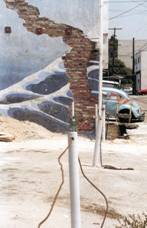
15. Baudrillard – Venice (1989)
under which any “real” Venice (California) is submerged. Baudrillard has also turned his camera to other such objects crying out to enter into the world of images in other cities. Soho (1987) and Montreal (1994) are two such images.

16. Baudrillard – Soho (1987)
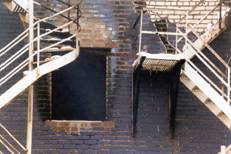
17. Baudrillard – Montreal (1994)
Such photographs as these (or Zoe Leonard’s Graham Electronics) take photography a long way from the culture of promotion where so many of our
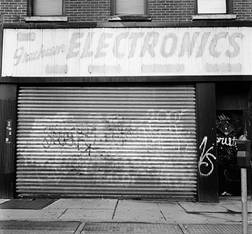
18. Leonard – Graham Electronics 28
values (including those of photographers), are now market values. Baudrillard with his eye for detail and Leonard are in no way seeking a kind of minimalism within the cities of the “first world”. Their eye for detail (Leonard’s work is akin to the American photographer of urban ruins Camilo José Vergara) is for the maximal effect of the ruin as part of daily life (one is reminded again of Rochelle Costi as well).
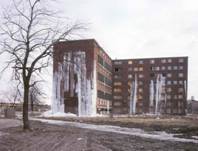
19. Vergara – West Lake St., Chicago (1995)

20. Vergara – Gas Station, Detroit (1998)
Leonard, like Vergara and Baudrillard, makes photographs which are well suited to the politically indifferent times of our transpolitical. Graham Electronics is also a recording of a building which is as indifferent to us as we are to it. This dual of indifference between subject and object, mediated by the photograph, operates as a kind of enigmatic memento-mori. Our own death and decay, and that of the system, are always just beneath the surface of such photographs and it is here that they make their challenge felt. Leonard’s photograph, like many of Vergara’s, show us a talent for listening to the ruined object’s demand to be photographed. In the place of meaning these images provide us with evidence of its radical loss. Leonard’s photograph’s of the fragments of urban deserts, especially the bricked up and boarded over windows she photographs, are metaphors for the end of former visions of progress.

21. Leonard – Wall (2002)
They are also, like Vergara and Baudrillard’s photographs of urban decay, memories of the inevitable and ongoing process of decay and in a strikingly optimistic and Baudrillardian manner melancholy is elevated to and ecstatic form of jouissance. Baudrillard has a remarkable appreciation for desert spaces of all kinds.
f) Light writing and dis(sing)appearance
The most important aspect of photography for Baudrillard is how well it engages with the object under conditions of natural light. Photographs record not only the fragments of the world but fragments of light as it breaks against the surface of the object (including the human object).29 At the heart of the photograph which interests me more than most others (as in Barthes concept of punctum)30 often rests the magnificent quality of natural light. Whatever else photography may be said to be, it is a record of the moment of convergence “between the light from the object and the light from the gaze”.31 The effect of natural light on objects often makes the world all the more enigmatic.
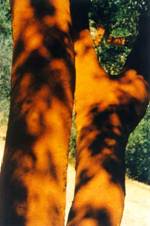
22. Baudrillard – Alentejo (1993)
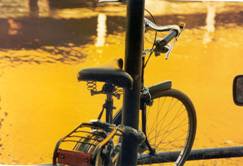
23. Baudrillard – Amsterdam (1989)
Baudrillard’s Alentejo (1993) and Amsterdam (1989) are excellent examples of photography of fragments of the world as light breaks revealing forms which destabilize our sense of reality.
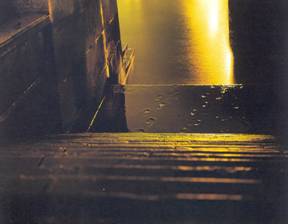
24. Luxemburg – In Deeper (1999)
Luxemburg’s In Deeper (1999) is a crepuscular image as is Baudrillard’s Amsterdam (1989). Is it a photograph of natural light? No, it is a photograph taken at night where the light comes from an old photographer’s tool – portable lighting. As such it constitutes a rigorous challenge, and an interesting one, to Baudrillard’s understanding of the place of natural light in photography. Luxemburg’s challenge points to the possibility that photography (understood in the Baudrillardian sense as “light-writing”) can be used to contribute to the enigmaticalness of the world. For me Luxemburg’s image ultimately fails in this regard, when placed next to Baudrillard’s Amsterdam (1989) which relies on the even more enigmatic qualities of natural light. The problem I am raising for Luxemburg’s fascinating images is that they possess a human-made aesthetic quality which is constructed by the photographer rather than recorded by the photographer as in Baudrillard’s photographs. While I appreciate that all photography (like all theory) is a simulation of an enigmatic world, Baudrillard’s photograph succeeds in accentuating this enigmatic quality without attempting to manipulate the scene. Amsterdam (1989) like Alentejo (1993) also do not rely on digital manipulations or aesthetic considerations but rather, are exemplars of “traditional” photography using natural light on film. They are images of objects which demanded the attention of the photographer under specific conditions of natural lighting. Luxemburg’s gorgeous image manufacturers the scene by way of the artificial intervention of staged lighting. Baudrillard’s images destabilize our sense of reality by photographing it under the conditions of its appearance – not a manufactured condition. In this process the object retains its power of attraction. The power of the object is (at least partially) ruptured in Luxemburg’s process and disappears when photographers add digital manipulations.
Today many digital photographers seek to replicate the stunning colour effects of Baudrillard’s Amsterdam and Alentejo using the artifical light of the digital. Two good examples of the extent to which some contemporary photographers are willing to go into the virtual and technological applications of colour are Florian Maier-Aichen and Sophy Richet. Maier-Aichen’s sumptuous Untitled (2005) is a visually stunning image – but it is not a photograph as

25. Maier-Aichen – Untitled (2005)
Baudrillard understands photography. Indeed it may be seen as a case of “anti-photography”32 which is an essential aspect of what Baudrillard referred to as the hostile takeover of photography by art. Maier-Aichen takes an iconic California highway (a scene along US-1), and manipulates the green scenery to appear in varying red tones. Some might argue that this mirrors Baudrillard’s efforts to show us an enigmatic and unintelligible aspect of our world which can be made to look like another world. But Baudrillard’s photographs (including Salins, see figure 8) accomplishes the effect without recourse to the artifical light of the computer screen. Maier-Aichen’s photograph reeks of artifical or computer light and is indeed not a photograph of this world – but an image of the world’s double which exists only inside the computer.
If Maier-Aichen is trying to show us that photography cannot be trusted it is a banal lesson today as we have learned it long before the digital. If however Maier-Aichen is attempting to make art, then he has succeeded. The one price that must be levied however is that we can no longer call this art “photography”. For photography to exist the object must remain a powerful part of the process demanding our attention as light breaks across it. In digital manipulation the object loses its force and natural light is usually eliminated. Perhaps the most profound outcome of the pictographic age that is the digital will be that it once again leads to a separation of “photography” and “art”. Photography may, in the end, prove too powerful for “art” to contain.
Another case of this use of digital technology to manipulate colours in a highly interesting way is Sophy Ricket’s Sodium Landscape (2003). While it is an
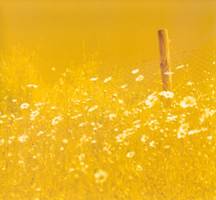
26. Ricket – Sodium Landscape (2003)
alluring image this is once again art, digital art, and not photography understood as an object and natural light based medium. Ricket’s “sodium landscape” might well be called “sulfurous landscape” if one were to attempt to breath the air in this computer modified and digitized fantasy where natural light is banished for the murky light of the screen.
From the point of view of photography in the human present however Ricket’s image seems merely a manipulation in relation to Baudrillard’s Amsterdam (1989) which is a photograph not of the real, but of the appearances behind which it hides under conditions of light. Like Goiris’s Ministry of Transportation (above), Baudrillard’s Alentejo and Amsterdam are records of the enigmatic quality of our world before computer manipulations which merely make the world more banal. If there is a challenge emerging from photographs like Sodium Landscape and Maier-Aichen’s Untitled it is to art rather than to photography.
Such images are not photographs from a Baudrillardian point of view but they are pictographs and they certainly qualify as art – but art is not photography. While Baudrillard was very happy seeing his images as photography (not art) for Maier-Aichen and Ricket their photographs are not photographs but “art’ by the time they are finished manipulating them. Perhaps such images (if future machines can read them) will be looked upon more fondly by future generations of artifical intelligence not unlike the way humans now tend to look fondly on the birth of photography in Joseph Nicephore Niepce’s A View From A Window At Graz (1826).

27. Niepce – A View From A Window At Graz (1826)
Much contemporary photography (like a good deal of contemporary art) and all computer generated images, captures only the sickly character of artifical light. We can understand this better if we look at three contemporary photographs (one by Baudrillard one by Peter Fraser and one made by a computer).
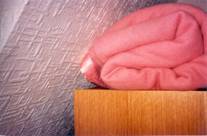
28. Fraser – Untitled (2004)
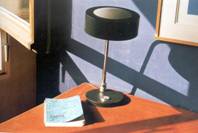
29. Baudrillard – Paris (1986)
Despite the presence of a window nearby (upper left) Fraser decides to shut out the light of the world in his photograph. The effect is one I am not entirely indifferent toward. Fraser’s photograph can be read as a statement about the real and the lack thereof – an artifical product (a blanket of man made fibers, sitting atop a bookcase of artifical wood, beside the artifical patterns of a painted and prefabricated wallpaper illuminated by the artifical light of the camera. It is a composition of a machine world that is also someone’s bedroom. But these objects are no less real than the lamp or table etc. in Baudrillard’s Paris (1986) with the critical difference that Baudrillard photograph uses natural sunlight.
Baudrillard’s image is not merely a record of the natural light, but the light of the object at the moment it seizes his attention holding a camera.33 Fraser’s digital pictograph adds a fabricated light to his image that comes from within the camera and the apparatus of digital reproduction. The heart of the problem rests with the fact that Fraser’s image has much more in common with a computer generated image (such as David Bliss’s River Valley) than does Baudrillard’s. While Fraser records objects he does so in a scenario where he holds all the power. In Baudrillard’s image the seductive qualities of the object in natural light share power with the photographer who has fallen under its spell.
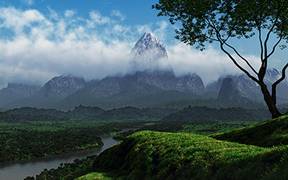
30. Bliss – River Valley (Computer Generated “Photograph”)34
Digital manipulation and computer generation have enabled the construction of many fantastic scenes. The AESF group35 has supplanted Frank

31. AESF Group – Guggenheim Bilbao (2006)
Gehry’s Guggenheim Bilbao with Islamic architectural features. While this work of collage raises interesting questions about Western and Islamic art, it is, in the end, a hallmark of the banality of computer generation. As in Fraser or Bliss’s work (above) the lighting is the sickly pale tone of the computer. In contrast to Baudrillard’s “light writing” which relies to no little extent on the photography of shadows (skiagraphy)36 there are no such strong shadows in digitality. It is here more than anywhere else that the prosaic nature of the digital holds sway in so much contemporary image making. Given the widespread knowledge of the building in question the work immediately appears as a banal fiction. It does not make the world more enigmatic merely more contrived and manipulated. This is a huge problem to which Baudrillard’s thought and images call attention – that contemporary photography is losing the ability to capture appearances and is in danger of falling into them forever. This is of course the continuing curse of abstraction (which photography has been exposed to in its captivity by art). As we move into the digital we work away from what Baudrillard called “evidence of appearances” toward the more fractal realm of abstraction.37
We encounter this difficulty in the work of two young photographers – Alexander Apostol and Luchezar Boyadjiev. Apostol is not a picture taker he is a
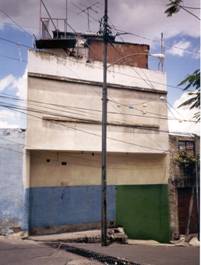
32. Apostol – Number 5, from the series: Residente Pulido, Ranchos (2003)
picture maker. Unlike Baudrillard’s New York (1986) – which is a picture taken of a street in the city – Apostol’s Number 5 is a picture made from the digital manipulation of multiple digital photographs. The result is a virtual building where all doors, windows and access points have been encased under digitally

33. Baudrillard – New York (1986)
managed closures. The subject matter is the same – both Apostol and Baudrillard show us modern urban ruins. However, Apostol’s fabrication itself is a ruin which suffers the ravages of real time whereas the ruin photographed by Baudrillard has been ravaged by historical time. Real time is the time of the digital. Apostol’s images of the Caracus barrios, like Baudrillard’s New York, are two images of failed utopia. We are left to wonder why, with so many failed utopias to photograph, someone would create another in the digital realm as Apostol has done? If this is “photography” in the “postmodern” then it is only so because photography has been emptied out in the postmodern. Perhaps this is appropriate given that “postmodernity” is itself an empty term used to designate an empty time in which there is nothing to express.38 If digital photography is not photography then perhaps it is photography’s clone.
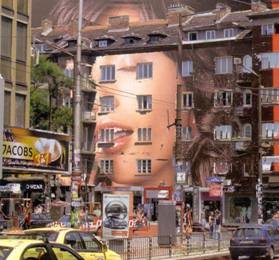
34. Luchezar Boyadjiev – Billboard Heaven (digital collage, 2005)
Baudrillard once told an interviewer something that may be of help in understanding the work of Apostol and that of Luchezar Boyadjiev. “All that remains to be done” he said “is playing with the pieces, that is postmodern”.39 Boyadjiev‘s collage is already an outdated idea (his effort to juxtapose life context and advertising culture) as advertisers in Europe have already begun to spread large advertising screens over buildings under renovation – including many apartment towers. It is however, an interesting example of the kind of “play” that has replaced a focus on the object as light breaks on it which was once the serious concern of something that was then known as photography.
Finally, the digital era is the time of the double – of a furious effort to replicate the world in image and data banks. Ours is the time of accelerated simulation. Humans have always loved to simulate the world in ideas expressed in both words (including poetry, literature, theory etc.) and in images. Perhaps the entire history of technology may now be read backward as an effort to develop powerful tools of simulation – somewhere we grew tired of the real hiding behind illusion as it always does and began to play with it. The result is a time when there is far more artificial intelligence in the world than traditional human grey matter. Kelli Connell’s images are a fitting place to end the discussion of contemporary photography in that she has made her own twin using images – a series of photographs of herself with herself such as Sunset which is one of a series of images called “Double Life”.

35. Kelli Connell – Sunset (2005) 40
Having attempted to double the world in the world of screens the image maker now doubles herself in this realm. In her effort to create a twin – or to “double” her existence – Connell’s effort fails as one image of herself effectively cancels out the other. There is no room for the world and its double and it is quite likely that “reality” will be taken for the imposture.41 Connell then, like many others described above, is an artist who uses a camera and not a photographer.
III. Conclusion
Whether they sit well beside Baudrillard’s images or stand in stark contrast to them – each of the images shown here remind us of the importance of Baudrillard’s writing on photography to future discussion of the image. The work of Tudela, Costi, Goiris, Kawauchi, Lê, Leonard, and Vergara exhibits a longing for Baudrillard’s texts while sometimes probing new solutions to problems present in them. The works of Luxemburg, Maier-Aichen, Ricket, and Fraser, poses a significant challenge to Baudrillard’s writing on photography albeit an unsatisfying one. Finally, the true importance of the image makers Bliss, AESF, Apostol, Boyadjiev, and Connell is that they usher us into the post photographic age. This is the image after Baudrillard – it may be art – but photography dies here.
About the Author
Gerry Coulter is the founding editor of the International Journal of Baudrillard Studies. He writes a regular column for Euro Art (Online) Magazine. Recent publications include: “One Among Several – The Traditional Gaze Seduced: Toward A More Complex Understanding of Eros in Modernism, appears in Kritikos: A Journal of Postmodern Cultural Sound, Text, and Image (July, 2007): http://intertheory.org/coulter2.htm. A review of Baudrillard’s books The Conspiracy of Art, and Utopia Deferred has recently appeared in the Canadian Review of Sociology and Anthropology.
A paper “Jean Baudrillard” and the Definitive Ambivalence of Gaming” appears in the SAGE journal Games and Culture, volume 2, number 4, December 2007. He has recently won Bishop’s Universities highest award for teaching – the William and Nancy Turner Prize.
Endnotes
1 – The author is grateful to Dr. Mary Ellen Donnan of Bishop’s University and Ms. Kelly Reid of the graduate program in Sociology at Queen’s University (Kingston, Canada) for suggestions and proof reading.
2 – Jean Baudrillard. Baudrillard Live: Selected Interviews. London: Routledge, 1993:165
3 – Jean Baudrillard. “It Is The Object Which Thinks Us” in Photographies: 1985-1998. Ostfildren-Ruit, Germany: Hatje-Cantz, 1999:146.
4 – Gerry Coulter and Kelly Reid. “The Baudrillardian Photograph As Theory: Making The World A Little More Unintelligible and Enigmatic” International Journal of Baudrillard Studies, Volume 4, Number 1 (January 2007).
5 – This is important as recent books on photography by authoritative figures have largely dismissed Baudrillard’s writings on photography. Perhaps the most significant of these is James Elkins Photography Theory (New York: Routledge, 2006). Elkins book reports the result of a roundtable dialogue by leading authorities on photography followed by written assessments of this dialogue by artists, academics and photographers. Curiously, while the discussion circles around photography’s “object” Baudrillard is not mentioned by the panel. Among those who replied to the discussion only Margaret Iverson, Johann Swinnen and Rosalind Krauss mention Baudrillard. Perhaps the reason for Baudrillard’s absence from the discussion has something to do with the selective bibliography’s functioning in the minds of the discussants and panelists. Rosalind Krauss perceptively points out that the panelists might read Barthes more closely. This for me is the key to the problem with the book. Despite their relative expertise in art and photography (or perhaps because of it) the book and its editor have a built-in defensive mechanism against Baudrillardian-style thinking. Without an adequate background in Barthes, Baudrillard’s writing on photography occupies another orbit.
6 – This is what Baudrillard describes as the task of thought see Jean Baudrillard. Impossible Exchange (c 1999). New York: Verso, 2001:151. Hence Reid and I understand Baudrillard’s photographs to be a kind of theory (see endnote 3).
7 – This and other of Tudela’s images are discussed at: http://www.carlfreedmangallery.com/content/view/19/33/1/2/
8 – Jean Baudrillard. Paroxysm. New York: Verso, 1998:4
9 – See also Jean Baudrillard. The Lucidity Pact Or The Intelligence of Evil. New York: Berg, 2005:71.
10 – Jean Baudrillard. Cool Memories. New York: Verso, 1990:230
11 – Reliance on artifical light is an issue of importance for a large portion of contemporary photography and one I discuss in some detail later when examining works which challenge Baudrillard’s understanding of photography.
12 – Jean Baudrillard. Symbolic Exchange and Death (c 1976). London: SAGE, 1993:4
13 – Jean Baudrillard. The Singular Objects of Architecture (with Jean Nouvel). Minneapolis: University of Minnesota Press, 2002:69.
14 – See Jean Baudrillard. Cool Memories IV. New York: Verso, 2002:26.
15 – Jean Baudrillard. Impossible Exchange. London: SAGE, 2001:17.
16 – Many discussions of photographic index founder precisely due to their lack of acknowledgement of the power of the object in the photographic act. An excellent example of this is found in James Elkins. Photography Theory. New York: Routledge, 2006.
17 – For a further discussion of the seduction of appearances see: Jean Baudrillard, Fatal Strategies: Crystal Revenge. New York: Semiotext(e), 1990:83. Translated by Philip Beitchman and W.G.J. Niesluchowski.
18 – See Jean Baudrillard. Paroxysm. New York: Verso, 1998:93; and Jean Baudrillard. Photographies (1985-1998) Ostfildern-Ruit, Germany: Cantz, 1999:136.
19 – Indeed, Bacon even does this with self portraits to record the presence of unknowable aspects of his own character etched across his face.
20 – See http://www.jmcolberg.com/weblog/2007/05/rinko_kawauchi_1.html (link no longer active 2019)
21 – Another excellent example of this kind of photograph of a person is Kelly Reid’s photograph of her sister. See Kelly Reid, Pointe-Claire (2003) in Section V of Gerry Coulter and Kelly Reid. “The Baudrillardian Photograph As Theory: Making The World A Little More Unintelligible and Enigmatic” International Journal of Baudrillard Studies, Volume 4, Number 1 (January 2007).
22 – See Jean Baudrillard. Photographies (1985-1998) Ostfildern-Ruit, Germany: Cantz, 1999:130.
23 – See Jean Baudrillard. Art and Artefact. London: SAGE, 1997:10.
24 – See also: http://www.vacarme.eu.org/IMG (link no longer active 2019)
25 – Jean Baudrillard. Illusion of the End (c1992). Stanford California: Stanford University Press, 1994:92.
26 – Jean Baudrillard Liberation, September 18, 1995 in Screened Out, 2002:85-86.
27 – Jean Baudrillard. Cool Memories III: Fragments. New York: Verso, 1997:63. See also Gerry Coulter and Kelly Reid. “The Baudrillardian Photograph As Theory: Making The World A Little More Unintelligible and Enigmatic”. International Journal of Baudrillard Studies, Volume 4, Number 1 (January 2007).
28 – See: http://www.artnet.com/artist/10384/zoe-leonard.html
29 – Jean Baudrillard. Fragments: Conversations With Francois L’Yvonnet. London: Routledge, 2004:100.
30 – Rolland Barthes. Camera Lucida: Reflections on Photography. New York: Hill and Wang, 1981:26 ff.
31 – Jean Baudrillard. The Lucidity Pact or, The Intelligence of Evil. London: Berg, 2005:104
32 – See Gerry Coulter. “Seizing the Object by the Throat – The Anti-Photography of Jeff Wall” in European Art Magazine Euro Art Number 2, (April-May, 2007).
33 – Jean Baudrillard. “It Is The Object Which Thinks Us” in Photographies: 1985-1998. Ostfildren-Ruit, Germany: Hatje-Cantz, 1999:146.
34 – See: http://www.digitalblasphemy.com/wip.shtml#rivervalley
35 – AESF is a group of four photographers: Tatiana Arzamasova, Lev Evzovich, Evgeney Svyatsky and Vladimir Fridkes.
36 – “skiagraphy” originally referred to “shadow painting”. See OED.
37 – See Jean Baudrillard. The Singular Objects of Architecture (with Jean Nouvel). Minneapolis: University of Minnesota Press, 2002:26
38 – Jean Baudrillard. Baudrillard Live: Selected Interviews. London: Routledge, 1993:22.
39 – Ibid.:95.
40 – See: letracorrida.blogspot.com/2006_09_01_archive.html (link no longer active 2019)
41 – See Jean Baudrillard. Impossible Exchange (1999). New York: Verso, 2001:3.